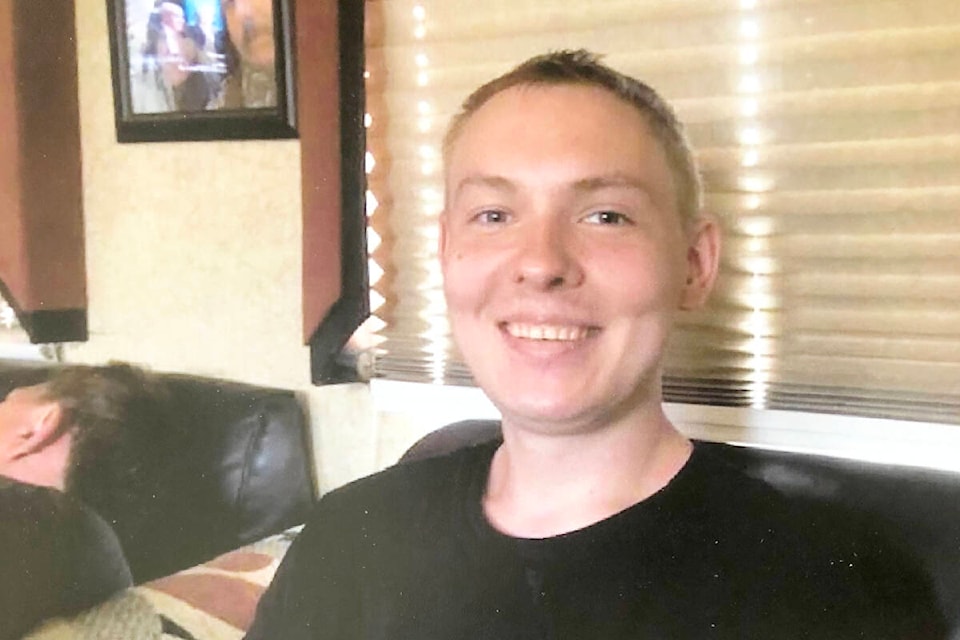Friday, Feb. 25 marks the one-year anniversary of a Williams Lake man’s accidental overdose death.
Matthew Bontron died alone in his supportive housing unit in Williams Lake after taking methamphetamine laced with fentanyl, his mother Shirley Ann Wheeler told the Tribune.
“My son had just turned 27 in January 2021,” Wheeler said, adding the drugs were purchased from a dealer in Boitanio Park.
“He was smart in one way, brilliant actually, but incapable other ways of looking after himself.”
Matthew had schizophrenia, likely from birth, but was misdiagnosed at an early age and prescribed Ritalin, she added.
After a year of almost debilitating grief, Wheeler, who lives at Big Lake, tuned into the BC Coroners Services report on Feb. 9, 2022 with great interest where chief coroner Lisa Lapointe confirmed 2,224 people died of suspected illicit drug-toxicity-related deaths in B.C. in 2021.
The chief coroner challenged decision-makers at all levels to recognize and respond to this public health emergency with the level of urgency it demands.
“The reality is this: every day we wait to act, six more people will die,” Lapointe stated in a news released. “COVID-19 has shown what is possible when governments act decisively to save lives. And in order to save lives in this public-heath emergency, we need to provide people with access to the substances they need, where and when they need them. Time has run out for research and discussion.”
The province needs to ensure, on an urgent basis, access across the province to a safe, reliable regulated drug supply, added Lapointe.
Wheeler agreed.
“Why wouldn’t you give them a safe supply of what they needed so they could stabilize and then maybe get off the drugs?” Wheeler asked, who noted she tried many times unsuccessfully to help get her son off drugs. “A lot of them want treatment to get off the streets, off the drugs, and not die. They are right beside people who are dying everyday. It’s not like they don’t know if they go to the street and take those drugs their number won’t come up.”
After her son’s death, his psychiatrist told Wheeler about the MomsStopTheHarm Facebook group which has helped her connect with other parents who have lost children to overdoses.
One of the successful treatment models she’s learned about since is in the Vermont Hub and Spoke that supports people in recovery from opioid use disorder.
“What interested me most was the stunning statistics that twice as many addicts entered treatment and the 98 per cent success rate of clean and sober at year three,” she said, explaining the model covers all the aspects of a person’s life that is needed to help them succeed.
Encouraging everyone to write letters to the federal government to push for change in Canada to ensure a safe drug supply, Wheeler said things have to change.
“Let us all citizens of Williams Lake create the change needed to save lives.”
During 2021 B.C. Emergency Health Services paramedics responded to 117 overdose calls in Williams Lake, 157 in Quesnel and 31 in 100 Mile House. So far in 2022, there have been at least 14 overdose calls in Williams Lake.
A spokesperson for BCEHS stated in an email that paramedics will tell you there is no typical overdose patient and the crisis is affecting people from all walks of life, throughout the province.
Overdose calls are increasingly complex, paramedics are administering more Naloxone than ever before due to the potency and toxicity of drugs and responding to overdose patients in cardiac arrest.
“This means it takes more time to stabilize a patient at the scene before transporting to hospital,” the spokesperson noted. “Paramedics deal with complications from an overdose including aspiration, trauma, frostbite, withdrawal symptoms and other effects.”
According to the BC Coroners Service since the public health emergency into substance-related harms was first declared in April 2016, more than 8,800 British Columbians have been lost to toxic drugs.
Fentanyl was detected in 83 per cent of samples tested in 2021. Carfentanil was present in 187 results, almost triple the number recorded in 2020 (66).
Additionally, 50 per cent of samples in December tested positive for etizolam, more than three times the rate of detection in July 2020 when it was 15 per cent. Benzodiazepines create significant challenges for life-saving efforts as naloxone does not reverse its effects. As with previous reporting, almost all test results included the presence of multiple substances.
In 2021, 71 per cent of those who died as a result of suspected drug toxicity were between 30 to 59, and 78 per cent were male.
By health service delivery area, in 2021, the highest rates of death were in Vancouver, Thompson Cariboo, Northwest, Northern Interior and Fraser East.
READ MORE: B.C. budget’s tax increases affect used vehicle sales, tobacco
READ MORE: 6 people died per day from B.C.’s toxic drug supply last year
news@wltribune.com
Like us on Facebook and follow us on Twitter
